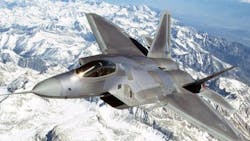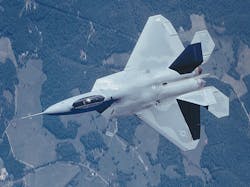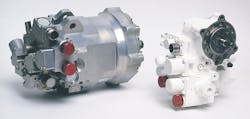Hydraulics efficiently operate weapon bay doors on F-22 Raptor
The F-22 Raptor is scheduled to take over the air dominance role with the Air Combat Command from the F-15 Eagle in 2004. Unveiled last year, the fighter was developed by a team of individuals from Lockheed Martin, Boeing, Pratt & Whitney, and the U.S. Air Force. The F-22's primary objective is to establish complete control of the skies — and it does this via the latest technology in low observables, avionics, materials, engine performance, aerodynamic design, sensor capability, and of course, weaponry. The F-22 is capable of carrying existing and planned air-to-air weapons, including medium-range missiles — such as the AIM-120A — and short-range missiles such as the AIM-9 Sidewinder.
Hydraulics has a hand in multiple functions of the Raptor; its 4000-psi system plays a role in rudder control, landing gear, nose wheel steering, flight control surfaces, and weaponry.
A hydraulic gun drive for the M61 A2 20-mm Vulcan cannon, is comprised of two discrete component subassemblies integrated into one assembly and provides rotary power to the 6-barrel gun when commanded by a computer signal or manual input. The system is integrally mounted in the aircraft on its starboard side between the top side of the wing and the fuselage. A gun door, located in the wing root area, is hydraulically controlled to open before the gun can be fired, which allows the rounds and blast pressure to clear the muzzle. A 480-round ammunition feed and storage subsystem is housed under the right wing for easy ammo upload and download of empty casings.
Missiles are stowed inside main and side weapon bays. Hydraulics controls the operation of these doors, which must swing open in an instant to allow the missile to be deployed in a fraction of a second. The F-22's primary weapon is the AIM-120 Advanced Medium-Range Air-to-Air Missile (AMRAAM). The AIM-120 was developed to provide an all-weather, all-launch environment capability not only for the F-22, but for the Air Force's in-service F-15 Eagle and F-16 Fighting Falcon and the Navy's F-14 Tomcat and F/A-18 Hornet as well. The missile has multiple-target engagement capability, increased maximum launch range, a reduced-smoke rocket motor, and improvements in maintenance and handling. The AIM-120 (which has no official nickname, but is called "Slammer" by pilots) is carried internally in the F-22's main weapons bay, which is located on the underside of the fighter tucked under the inlets. The main bay is covered by two thermoset composite bifold doors that open outward.
Each missile is carried on an EDO Corp.-built LAU-142/A hydropneumatic launcher, called an AMRAAM Vertical Eject Launcher (AVEL). The AVELs are substantial — nearly 113 lb each — in order to minimize missile movement in the weapons bay. They are made mostly of aluminum, have a 9-in. stroke, and eject the missile out of the bay at more than 25 ft/sec with a force of 40 Gs at peak acceleration. Unlike conventional missile launchers on other aircraft, the AVELs require no pyrotechnics, and need less logistics support than other launchers.
The entire launch sequence (door opening, AVEL ejecting the missile, missile ignition and flyout, door closing) takes just seconds. The combination of the F-22's stealth characteristics, its integrated avionics, the help of hydraulics, and the AIM-120 missile gives this fighter a first-look, first-shot, first-kill capability.



